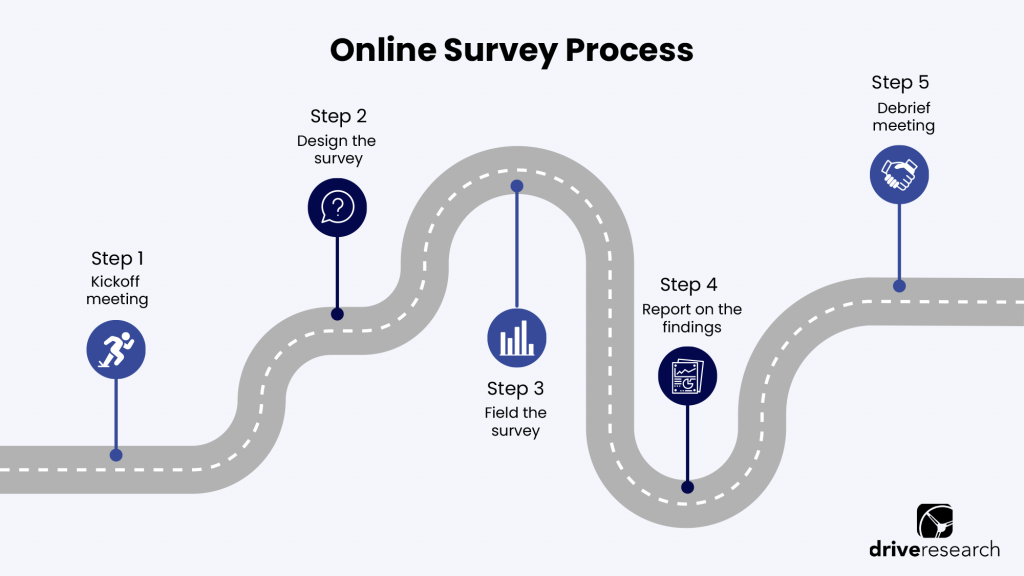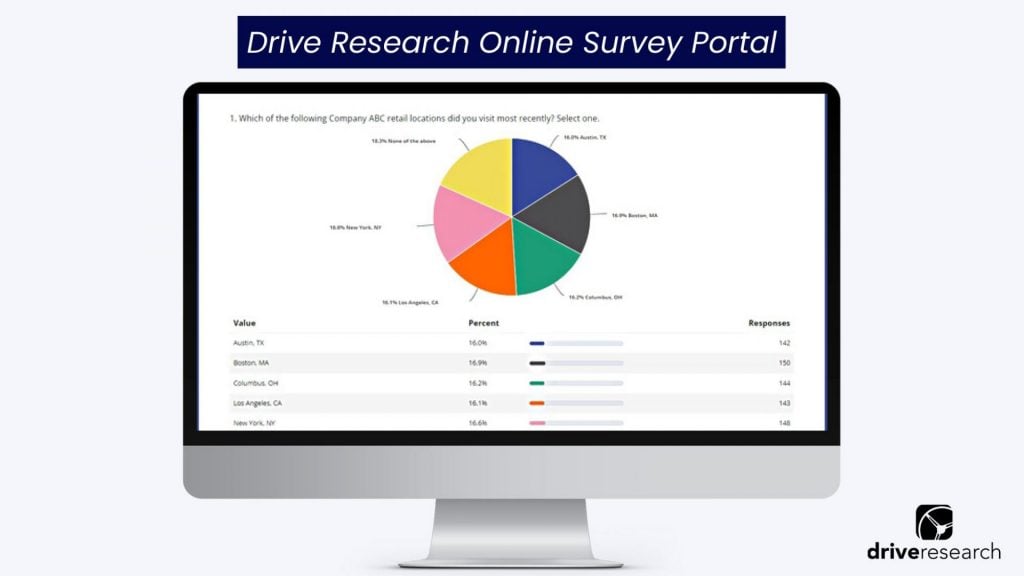
Most insurance companies now cover telemedicine visits, which means more patients and healthcare providers are skipping the in-office experience for virtual consultations.
Even with the pandemic behind us, healthcare providers are still offering telehealth as an option because of its ability to reach patients anywhere.
In fact, up to 80% of doctors believe their patients have improved access to medical care by using telemedicine methods.
With its ongoing usage, telemedicine satisfaction questionnaires are essential in understanding and improving the provider-patient relationship, especially as technology continues to evolve in the healthcare industry.
In this blog post, Drive Research, a healthcare market research firm, will explain the top 10 questions healthcare organizations should include when surveying patients regarding their experience using telemedicine.
What is a Telemedicine Satisfaction Questionnaire?
A telemedicine satisfaction questionnaire is a tool used to assess patients’ satisfaction with telemedicine services.
Telemedicine involves the use of technology to provide healthcare services remotely, and a satisfaction questionnaire is designed to collect feedback from patients about their experience with this type of healthcare delivery.
It is also referred to as telehealth satisfaction surveys.
A typical telemedicine satisfaction questionnaire may include questions related to:
- The ease of use of the technology
- The quality of communication with the healthcare provider
- The effectiveness of the telemedicine visit in addressing the patient’s health concerns
- Overall satisfaction with the experience
The Key Takeaway: Telemedicine satisfaction surveys measure the patient experience online. They cover key topics related to care and ease of use.
How Do You Measure the Effectiveness of Telehealth?
The effectiveness of telehealth can be measured through several healthcare market research options such as surveys, focus groups, and in-depth interviews.
Though, online surveys are most commonly used when measuring patient satisfaction. That’s because they are cost-effective, offer a fast turnaround time, and are widely accessible.
Below, our healthcare market research company outlines the steps we implement when measuring the effectiveness of telehealth with patient satisfaction surveys.

1. Kickoff meeting
The kickoff meeting acts as an introduction between your team and the market research team. You’ll discuss the basics and what you want your telemedicine satisfaction questionnaire to accomplish.
Typically, the following components will be discussed in a kickoff meeting:
- Project goals
- Timeline of project
- Client concerns
With every market research study, our market research company customizes survey questions based on the specific goals and objectives of the healthcare organization.
This is an important step in the process because it assures your voice is heard and represented through the survey script.
We do not offer a templated set of questions, but instead, write a questionnaire that is representative of your unique needs.
2. Designing and writing the survey
After the kickoff meeting comes the part where your survey is created. This is done in a Word or Google document by the research team.
Using the feedback obtained from the kickoff, they’ll create a set of questions.
The number of questions you should ask in a survey varies, but we recommend keeping it to no more than 20 questions.
Writing a telemedicine satisfaction questionnaire includes:
- Ensuring questions are well-written and clear
- Keeping questions unbiased
- Paying attention to the style of questions included
3. Collecting telemedicine patient feedback
Your telemedicine satisfaction questionnaire will then be taken from its original document and programmed into an online survey platform.
Fieldwork simply refers to the period of time when responses are collected from patients. Usually, this takes a few weeks – but the timing really depends on the goals of your survey.
As the survey is in the field, your team will receive a live reporting link. This allows our clients to see responses in real-time to check the progress and get a sneak peek at the feedback collected thus far.

Use our interactive link to see how the client portal works
4. Analysis and reporting
After fieldwork ends, the responses are collected by the customer satisfaction survey company and evaluated.
It’s important to have the questions carefully “cleaned” for errors.
This entails looking for speedy completion times, duplicated entries, and other signs of poor survey respondents.
After the data is cleaned, a thorough report will be created. The report covers all the key data that was found in your survey.
Below is what we’ll typically include in our reports:
- Key findings
- Question-by-question analysis
- Common themes among responses
- Data visualizations and infographics
- Ways to use the data effectively
Our market research firm will also hold a debriefing meeting to go over the findings from the telemedicine satisfaction questionnaire. This allows your team to ask any final questions or address concerns.
The Key Takeaway: An effective market research process for measuring the effectiveness of telehealth includes a series of important steps. This results in the highest quality data for the client to use.
Example Telemedicine Survey Questions
With every market research study, our team customizes survey questions based on the specific goals and objectives of the healthcare organization.
Although all of our telemedicine survey questions are custom-written, we can provide an overview of the types of questions we recommend.
These are based on our past experiences working with healthcare organizations and how they’ve used the results from the insights derived from the survey.
Example telemedicine satisfaction survey questions every healthcare organization should consider include:
- Why did you choose telemedicine for your most recent visit?
- Would you recommend using telemedicine to a family member or friend?
- Overall, how would you rate your most recent experience using telemedicine?
- How likely are you to choose telemedicine for your next appointment?
- Were you seen within 15 minutes of your scheduled appointment time?
- How would you rate the amount of time your healthcare provider spent with you?
- Did you feel your privacy was respected during your telemedicine visit? Why or why not?
- How satisfied were you with your provider’s thoroughness while using telemedicine?
- Did you experience any technical difficulties while using telemedicine? If yes, please explain.
- Did your healthcare provider give you easy-to-understand instructions?
Below, Drive Research explains the reason to include these questions.
1. Why did you choose telemedicine for your most recent visit?
For healthcare practices, this is an important question to ask when trying to determine when to offer telemedicine visits.
Depending on the answer options, your healthcare team will be able to better understand the important factors in the patient decision-making process.
Some example answer options may include:
- Visit type (i.e., sick or well-check)
- Health/safety (i.e., immunocompromised)
- Location/distance to the office
- Save time
- Frequency of visit (i.e., monthly check-in)
2. Would you recommend using telemedicine to a family member or friend?
Net Promoter Score (NPS) is a common question type used in market research and should certainly be used in healthcare.
NPS is an excellent way to measure your patients’ perception of how your practice is utilizing telemedicine.
In addition, the healthcare net promoter score is a great indicator of growth, meaning if patients are promoters (score 9 or 10) rather than passives (score 7 or 8) and detractors (score 0 to 6), your healthcare practice may be able to interpret the increasing preference and meet the need for telemedicine as opposed to in-office visits.
To learn more about calculating net promoter score, watch this short video.
3. Overall, how would you rate your most recent experience using telemedicine?
This question gives healthcare providers the ability to see telemedicine from the patients’ perspective.
Allowing patients the opportunity to rate their most recent experience using telemedicine gives a lot of insight into how patients are liking or disliking telemedicine overall.
4. How likely are you to choose telemedicine for your next appointment?
Patient satisfaction in healthcare relies heavily on word of mouth.
Similar to NPS, this question offers valuable insight into the patient decision-making process.
Asking patients if they would choose to use telehealth again for their next appointment allows your practice to determine if patients are enjoying telemedicine and if they want to continue using it.
This question also allows healthcare professionals to better understand the demand for virtual visits as opposed to in-office visits.
Recommended Reading: How to Conduct a Patient Loyalty Survey
5. Were you seen within 15 minutes of your scheduled appointment time?
For patients using telemedicine, asking about the length of time spent in the virtual waiting room is important in understanding how wait times impact patient satisfaction.
This question can help healthcare practitioners balance providing thorough, quality healthcare and shorter wait times.
If in-person, a long wait time is typically expected, regardless of how frustrated they may be. However, for remote appointments, there is more of an expectation that their consultation will start exactly on time.
It’s treated like a Zoom meeting where it would be extremely unprofessional if someone was late to a client call.
6. How would you rate the amount of time your healthcare provider spent with you?
When using telemedicine, patients want to feel they’re receiving the same quality of care that they would receive in a doctor’s office.
It is important that their health concerns are taken seriously. Because consultations are done virtually, it requires the patient to provide descriptive answers to your telemedicine satisfaction questionnaire.
Asking patients if they feel their healthcare provider spent enough time with them is crucial in improving and maintaining a high quality of healthcare while using telehealth.
If the survey shows that the consultation was too short, or they felt rushed, this might be an indicator that you need to factor in longer appointment times.
7. Did you feel your privacy was respected during your telemedicine visit? Why or why not?
In nearly every telehealth visit I’ve had so far, my healthcare provider has mentioned HIPAA.
My doctor tells me where they are, who is around them, and mentions that those around me may also be able to hear our conversation.
Asking patients if they feel their privacy was respected during their virtual appointment makes them feel comfortable using telemedicine and discussing their health via video chat.
Adding this to a telemedicine satisfaction questionnaire also helps identify opportunities for improvement when it comes to patient privacy and security.
8. How satisfied were you with your provider’s thoroughness while using telemedicine?
Asking patients if they feel satisfied with their healthcare provider’s thoroughness while using telemedicine might be one of the most important questions to ask.
For example, talking to a healthcare provider on the phone is a completely different experience than an in-office visit.
There are certain limitations to telehealth, and covering this in a telemedicine satisfaction questionnaire is essential to identifying and creating solutions for those restrictions.
9. Did you experience any technical difficulties while using telemedicine? If yes, please explain.
In many cases, while using telemedicine, there are factors outside of your control as a healthcare practice.
Asking patients about any difficulties they experienced while using telemedicine is extremely important to improving the patient experience. Asking about technical problems experienced can identify issues early on.
The technical difficulties that are realized through such a question may identify opportunities for your healthcare practice, such as providing more clear login and usage instructions or switching telemedicine software providers.
A telemedicine satisfaction questionnaire will also cover how patients handle follow-up instructions.
When a patient comes in for an in-office appointment, it’s easy to print out a diagnosis and send them on its way to the pharmacy. However, telemedicine lacks the in-person element, which creates some room for patient confusion.
This question is important in understanding how to meet patient needs most effectively so they understand what to do next.
A great follow-up to this question might be what the patient’s communication preferences are so they’re able to send them their diagnosis and treatment information in the most convenient way for the patient.
The Key Takeaway: Telemedicine survey questions cover a wide variety of sub-topics. This is to ensure data is well-rounded and easy to understand.
Telemedicine Satisfaction Questionnaire Best Practices
Drive Research has a strong understanding of market research within the healthcare industry.
When it comes to patient satisfaction surveys, our full-service market research firm has learned a thing or two about increasing response rates and collecting high-quality data.
1. Follow-up Quicky
Waiting too long after a telehealth appointment to send out a patient satisfaction survey leaves room for error.
Sending the survey immediately after the telehealth appointment allows the patient to answer the questions while their experience using telemedicine is still top of mind.
2. Offer Incentives for Survey Completion
Offering rewards for market research, such as the opportunity to enter a drawing for a $50 Visa gift card, is a great way to boost response rates and collect feedback from more patients.
This gives your healthcare practice more feedback to work with, allowing you to make more effective decisions regarding patient satisfaction.
3. Focus on a Few Key Objectives
Keeping patient satisfaction surveys short and to the point creates a much more positive experience for respondents.
This means patients will be more likely to take their time and respond carefully to each question.
4. Pay Closer Attention to Negative Feedback
It’s important to pay special attention to the critiques your survey receives.
By implementing the strategies suggested by your patients, you’re automatically improving their experience. In turn, this can also boost word-of-mouth referrals and increase your patient numbers.
The Key Takeaway: The questions you include in your survey make all the difference when it comes to response quality. In order to get the patient feedback you need, it’s important to include questions that are designed to get that feedback.
Final Thoughts
Telemedicine satisfaction questionnaires are essential in understanding and improving the provider-patient relationship, especially as technology continues to evolve in the healthcare industry.
With surveys, the effectiveness of telehealth can be measured through various metrics such as:
- Patient outcomes
- Patient satisfaction
- Cost-effectiveness
- Provider satisfaction
- Access to care
By collecting feedback through a telemedicine satisfaction questionnaire, healthcare providers can identify areas where improvements can be made to enhance the patient experience and improve the quality of care delivered through telehealth.
Contact Our Healthcare Market Research Company
As a national market research company specializing in healthcare organizations, Drive Research is experienced in conducting qualitative and quantitative studies for providers across the country. Most commonly, our team creates custom telemedicine satisfaction surveys to provide unique and action-driven insights.
Interested in learning more about our services? Contact us today!



